#sustainable homesteading
Text
WELCOME TO THE WORLD OF HERDING DOGS: A REMARKABLE TRAINING JOURNEY
In this blog article, we’ll delve into a comprehensive 5-step guide to training your herding dog using ducks. Let’s explore how you can lay a solid foundation for your dog’s herding skills while fostering a harmonious relationship with livestock.STEP 1: ESTABLISHING BASIC OBEDIENCE AND BONDINGTo begin, teach your herding dog essential obedience commands like sit, stay, and recall. By focusing on…
View On WordPress
#agroforestry#best bucking bulls#dogs and handlers&039; skills.#eco-friendly farming#rodeo#sustainable food production#sustainable gardening#sustainable homesteading#sustainable living#sustainable ranching
0 notes
Text
Homemaking, gardening, and self-sufficiency resources that won't radicalize you into a hate group

It seems like self-sufficiency and homemaking skills are blowing up right now. With the COVID-19 pandemic and the current economic crisis, a lot of folks, especially young people, are looking to develop skills that will help them be a little bit less dependent on our consumerist economy. And I think that's generally a good thing. I think more of us should know how to cook a meal from scratch, grow our own vegetables, and mend our own clothes. Those are good skills to have.
Unfortunately, these "self-sufficiency" skills are often used as a recruiting tactic by white supremacists, TERFs, and other hate groups. They become a way to reconnect to or relive the "good old days," a romanticized (false) past before modern society and civil rights. And for a lot of people, these skills are inseparably connected to their politics and may even be used as a tool to indoctrinate new people.
In the spirit of building safe communities, here's a complete list of the safe resources I've found for learning homemaking, gardening, and related skills. Safe for me means queer- and trans-friendly, inclusive of different races and cultures, does not contain Christian preaching, and does not contain white supremacist or TERF dog whistles.
Homemaking/Housekeeping/Caring for your home:
Making It by Kelly Coyne and Erik Knutzen [book] (The big crunchy household DIY book; includes every level of self-sufficiency from making your own toothpaste and laundry soap to setting up raised beds to butchering a chicken. Authors are explicitly left-leaning.)
Safe and Sound: A Renter-Friendly Guide to Home Repair by Mercury Stardust [book] (A guide to simple home repair tasks, written with rentals in mind; very compassionate and accessible language.)
How To Keep House While Drowning by KC Davis [book] (The book about cleaning and housework for people who get overwhelmed by cleaning and housework, based on the premise that messiness is not a moral failing; disability and neurodivergence friendly; genuinely changed how I approach cleaning tasks.)
Gardening
Rebel Gardening by Alessandro Vitale [book] (Really great introduction to urban gardening; explicitly discusses renter-friendly garden designs in small spaces; lots of DIY solutions using recycled materials; note that the author lives in England, so check if plants are invasive in your area before putting them in the ground.)
Country/Rural Living:
Woodsqueer by Gretchen Legler [book] (Memoir of a lesbian who lives and works on a rural farm in Maine with her wife; does a good job of showing what it's like to be queer in a rural space; CW for mentions of domestic violence, infidelity/cheating, and internalized homophobia)
"Debunking the Off-Grid Fantasy" by Maggie Mae Fish [video essay] (Deconstructs the off-grid lifestyle and the myth of self-reliance)
Sewing/Mending:
Annika Victoria [YouTube channel] (No longer active, but their videos are still a great resource for anyone learning to sew; check out the beginner project playlist to start. This is where I learned a lot of what I know about sewing.)
Make, Sew, and Mend by Bernadette Banner [book] (A very thorough written introduction to hand-sewing, written by a clothing historian; lots of fun garment history facts; explicitly inclusive of BIPOC, queer, and trans sewists.)
Sustainability/Land Stewardship
Braiding Sweetgrass by Robin Wall Kimmerer [book] (Most of you have probably already read this one or had it recommended to you, but it really is that good; excellent example of how traditional animist beliefs -- in this case, indigenous American beliefs -- can exist in healthy symbiosis with science; more philosophy than how-to, but a great foundational resource.)
Wild Witchcraft by Rebecca Beyer [book] (This one is for my fellow witches; one of my favorite witchcraft books, and an excellent example of a place-based practice deeply rooted in the land.)
Avoiding the "Crunchy to Alt Right Pipeline"
Note: the "crunchy to alt-right pipeline" is a term used to describe how white supremacists and other far right groups use "crunchy" spaces (i.e., spaces dedicated to farming, homemaking, alternative medicine, simple living/slow living, etc.) to recruit and indoctrinate people into their movements. Knowing how this recruitment works can help you recognize it when you do encounter it and avoid being influenced by it.
"The Crunchy-to-Alt-Right Pipeline" by Kathleen Belew [magazine article] (Good, short introduction to this issue and its history.)
Sisters in Hate by Seyward Darby (I feel like I need to give a content warning: this book contains explicit descriptions of racism, white supremacy, and Neo Nazis, and it's a very difficult read, but it really is a great, in-depth breakdown of the role women play in the alt-right; also explicitly addresses the crunchy to alt-right pipeline.)
These are just the resources I've personally found helpful, so if anyone else has any they want to add, please, please do!
#homemaking#homemaking resources#gardening#urban gardening#self sufficiency#self sufficient living#sustainability#sustainable living#homesteading#nontrad homemaker#nontrad housewife#urban homesteading#solarpunk#cottagecore#kitchen witch#kitchen witchcraft#crunchy to alt right pipeline#book rec#book recommendations#resource#long post#mine#racism tw#racism mention#transphobia tw#transphobia mention
2K notes
·
View notes
Text
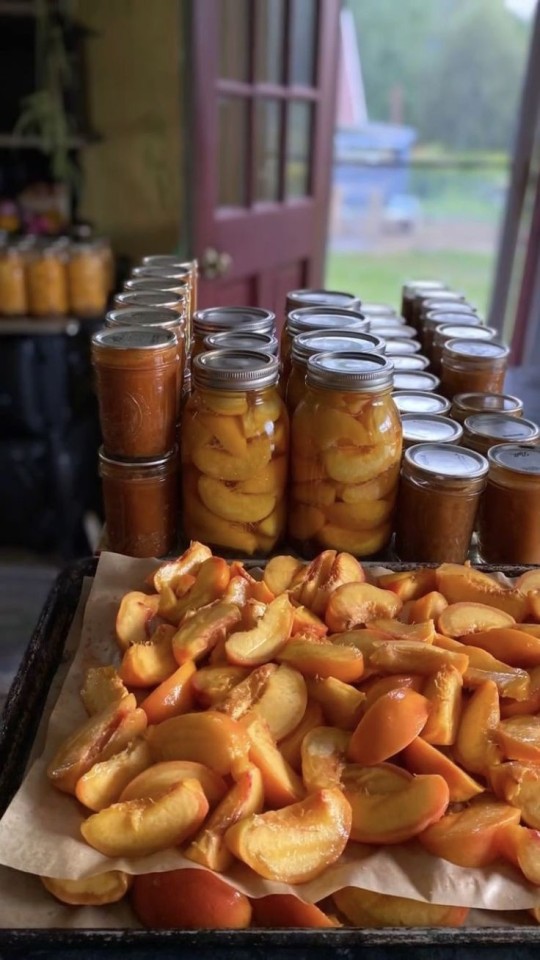


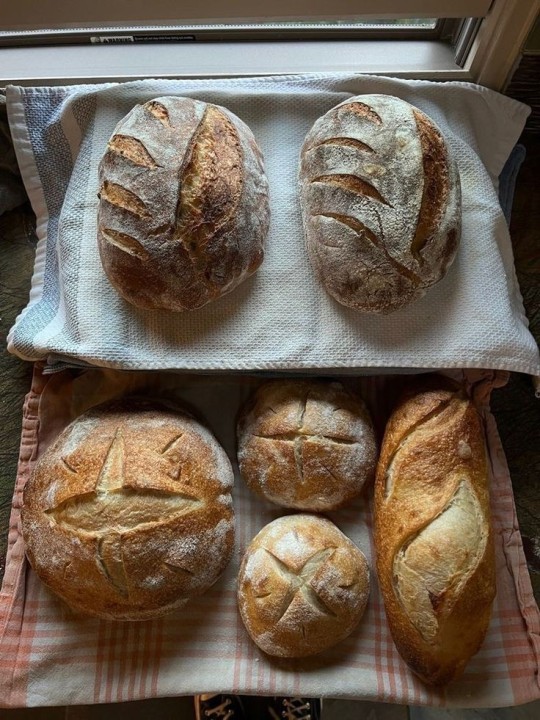
✨
#farmcore#farm aesthetic#homesteading#homesteading aesthetic#eggs#chicken eggs#preserving#self sustainability#cottagecore#comfortcore
633 notes
·
View notes
Text
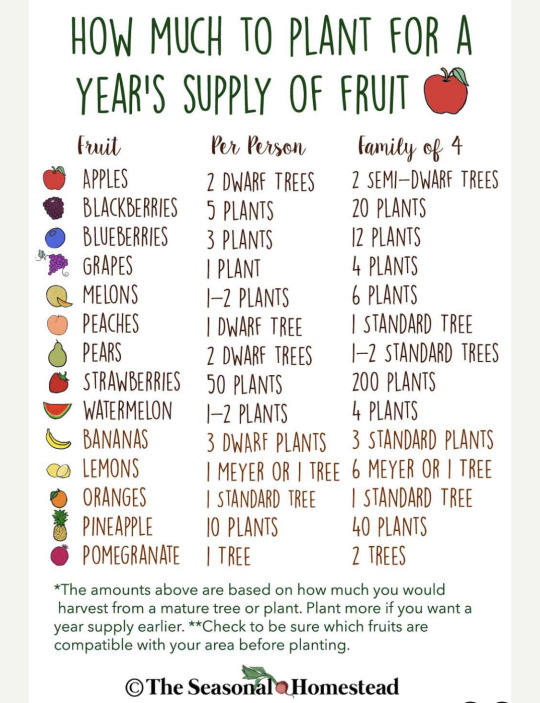
📸 The Seasonal Homestead
#homestead#garden#gardening#homesteading#self sufficient#self sustainable#urban farm#self sustainability#fruit#fruit trees#grow your own food
559 notes
·
View notes
Text

𝐁𝐢𝐨 ~ 𝐀𝐥𝐢𝐜𝐞 𝐁𝐚𝐫𝐛𝐞𝐫 𝐒𝐭𝐞𝐩𝐡𝐞𝐧𝐬 {𝑎𝑚𝑒𝑟𝑖𝑐𝑎𝑛 1858~1932}
99 notes
·
View notes
Text

How to become self sufficient on a ¼ acre!
(OP was a white nationalist, so take this one instead)
226 notes
·
View notes
Text
My chickens. 🌿🐓✨
37 notes
·
View notes
Text
Good afternoon everyone~
It's cold, windy and it's been raining on and off all day but I finally got out to harvesting the sweet potatoes.
I started with the 'L' bed.

This is the bowl I'll be using to collect the spuds for this deep raised bed.
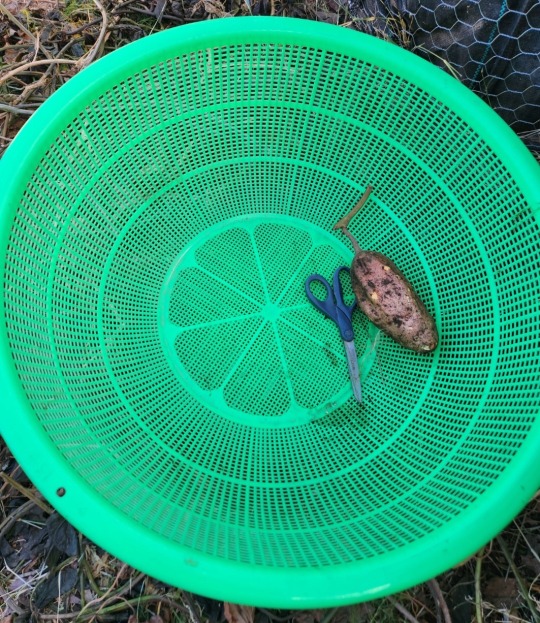
Those are full size scissors btw. This is the absolute biggest strainer I own and when I do harvesting I'm always glad to have it! Helps with carrying and washing off dirt outside so much easier!

It was pretty fun digging round for the spuds and to be honest the size and shape of some of them really suprised me!

For some size comparison, my hand is right on top of them.
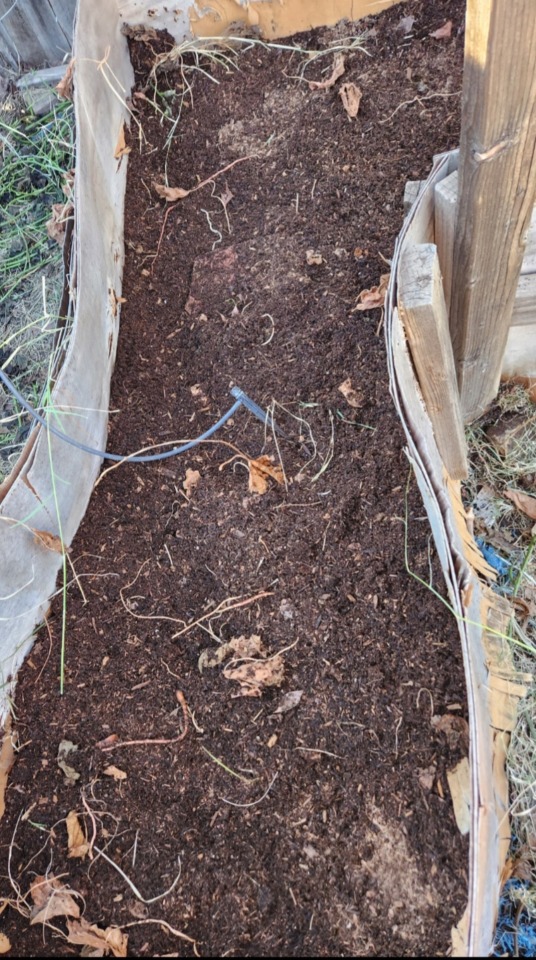
All cleaned out!
Next was the little round bed in the corner. I wasn't really expecting much, but it filled the bin pretty good.

I've washed the spuds off and am letting them dry off but I'll be finding a spot inside soemwhere to let them sit and cure for a bit of time. (I probably will let them cure until end of febuary.)
Curing your sweet potatoes is what makes them sweet, you can eat them right away but their said to be bitter. (I will be trying 1 potato to see if this is true!) Curing them should be done for at least 2 week in a cool dry space (around 80*f). If you under 80*f space add 7 more days.
I thought this was neat and wanted to share it. since I've not seen a sweet potato grown or dug up before

I wasn't expecting so much differance in spud size from one single root.
And one last pic,
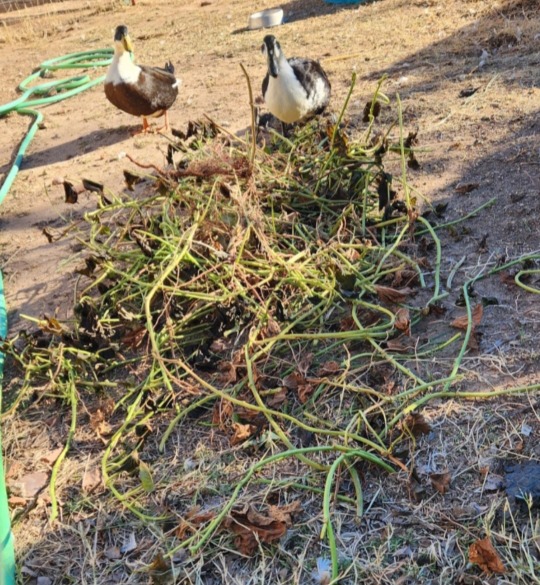
The ducks quite like the greens, while there's not much left of it I'm going to leave the vines a couple days so they can use it as enrichment/snack opportunity.
Weigh in on the spuds later!
🍠🌱Happy Homesteading and Harvesting!!
🌱🍠
1.11.2024
#self sufficient living#homesteading#thestudentfarmer#studentfarmer#self sufficiency#food#garden#gardening#low waste#duck#sustainability#smalls scale differences#urban animal keeping#urban biodiversity#urban homesteading#urban gardening#urban farming#grow what you can#simple plants to grow#multipurpose crops#right to grow#human right to clean food#right to grow food#raised garden beds#start to finish#will it grow?#food sovereignty#whole foods#first time growing#going green as can be
60 notes
·
View notes
Text
The chicken came up to the garden today to demand some snacks! 🐓
#hedge witch#cottagecore#green witch#forestcore#naturecore#witch aesthetic#goblincore#witchcore#cottage aesthetic#cottage witch#slow life#slow living#solarpunk#sustainability#homesteading#grow your own food#garden witch#gardening#garden#pagan witch#folk witchcraft#folkcore#folk magic#chicken
27 notes
·
View notes
Text

4/26/24 - Jalapeño update!
#jalapeno pepper#growing peppers#pepper garden#gardening blog#edible gardening#indoor garden#sustainable gardening#container gardening#vegetable gardening#starting seeds#growing food#plant life#plant mom#veganuary#homesteading
24 notes
·
View notes
Text
8 Key Tips to Choose the Perfect Bucking Horse Trainer: Unleash the Cowboy Permaculture Spirit!
Why we might be the next trainer for your bucking horses after all. Sometimes you need to know who, what, when, where and why to take action. Now you can.
Introduction:Are you a stock contractor seeking the perfect bucking horse trainer to take your rodeo game to new heights? Look no further! In this blog post, we’ll delve into the world of cowboy permaculture and present you with eight key tips to convince you why we are the ideal choice for your bucking horse training needs. Get ready to unleash the spirit of the wild west and revolutionize your…
View On WordPress
#cowboy lifestyle#cowboy permaculture#holistic land management#nature conservation#sustainable farming#sustainable food production#sustainable homesteading#sustainable living#sustainable ranching#sustainable resource management
0 notes
Text



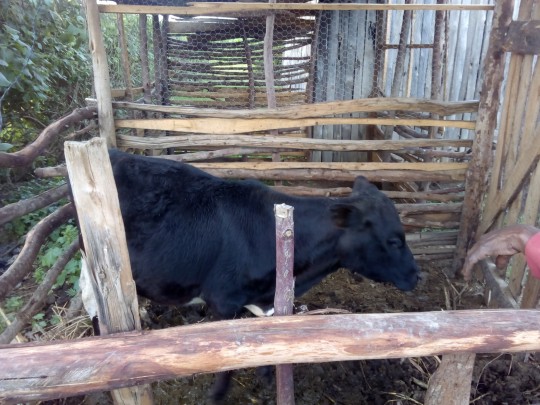

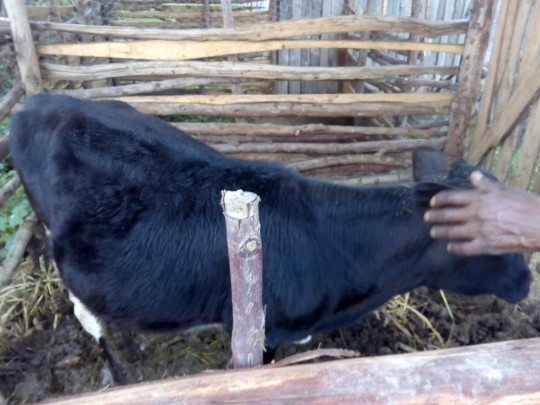
17 notes
·
View notes
Text

52 notes
·
View notes
Text
Which way does your garden face?
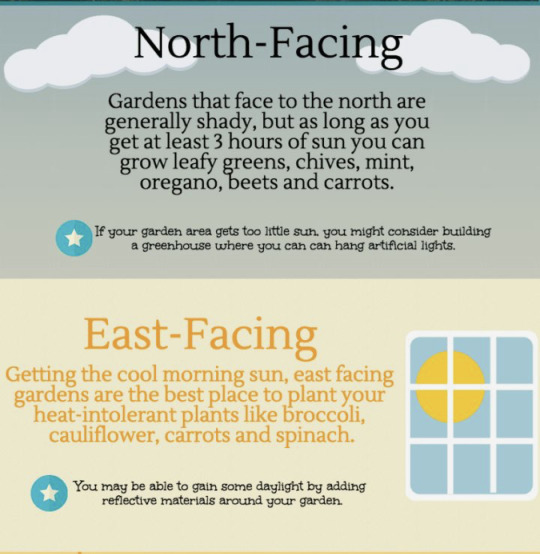

Ref: Youshouldgrow.com
#homestead#garden#gardening#homesteading#self sufficient#self sustainable#urban farm#self sustainability
154 notes
·
View notes
Text
Operation Lawn Replacement

All the little reddish seeds that are starting to sprout are mini white clover seeds. I threw fistfulls of these seeds all over my front yard a day ago, and they're already starting to sprout after the rain we've had.
As my update on my last post says, I recently bought a house. My first one ever. *excited squealing* One of the first things I'm doing is replacing the lawn with mini clover. This will probably irritate my neighbors, but since there is no HOA (I wouldn't have bought it if it did), I don't care. There are several reasons why I am doing this:
• mini clover only grows about 6 inches tall max, so it does not require mowing
• clover, being a legume, is a nitrogen fixer, which helps enrich the soil, and doesn't require massive amounts of fertilizer to stay green
• clover is broad leafed, so is better at shading out other undesirable plants/weeds, which means it doesn't require massive amounts of herbicides to create a uniform lawn (I am not advocating for monocultures here, but if that's what you want, then clover does it better than grass)
• clover emerges from dormancy sooner in the spring, stays green in the fall/winter longer, and requires less watering than grass, so it looks nicer when everyone else's lawns are dead and brown due to changing seasons or drought
• clover produces beautiful little white flowers that bees and butterflies love, which supports and attracts these pollinators to other areas of the garden
• clover leaves and flowers are edible
I'm sure there are other reasons I'm forgetting, but I think this is enough reason to lose the grass with its shallow roots and intensive care in favor of something simpler and prettier.
13 notes
·
View notes
Text
Looking for villagers
If any of you are late diagnosed ND/autistic person, ideally are UK based (though if you're willing to go through all the annoying processes you can come from wherever) and are a kind, empathetic, amiable, conscientious person and would be up for living the English countryside permaculture homesteading life in community with me, my husband, our future kids, other autists and NDs and all our animals then feel free to message me with a little bio about you, and I'll put you on my list that I'm compiling of potential villagers
It will be beautiful and lovely and lgbt friendly as well of course
#solarpunk#hopepunk#hopecore#peaceful revolution#greenhorizon#anti capitalism#climate change solutions#naturecore#forestcore#lunarpunk#homesteading#cottagecore#england#britain#community#intentional living#intentional community#sustainability
14 notes
·
View notes